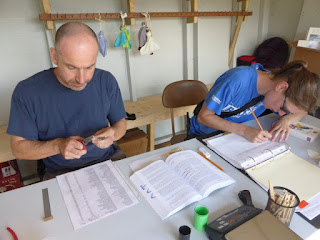I recently caught this first winter Dunnock with a damaged or deformed lower mandible.
It seemed to be coping well and had a weight of 21.8 gms. It is difficult to imagine how it might have lost the bill tip, so it might be a deformity. The upper mandible does seem to have grown a little longer and more curved at the tip than normal.
Thursday, 22 October 2015
Monday, 5 October 2015
Banding in Canada.
Paula still does not believe me that it was pure luck that I came across two great active ringing sites on our recent trip to the St Lawrence. The first was at Reserve nationale de faune du Cap- Tourmente, an hours drive east of Quebec City. This is a new site that had just started up. I especially loved the ringing hut!
All looks much as it would at a UK ringing station. What is great about seeing ringing abroad is that you always come away with ideas that might help your ringing at home.
I liked the large information boards that they had printed on plastic sheets. These could be passed round.
They use rings which are closed and on wires in these film canisters. The rings have to be opened using a sprocket on the pliers.
At Tourmente they used wooden posts, which are ridged and allow low guying. I liked the tennis balls on the pegs for safety. Below a close up of the sprocket on the pliers for ring opening.
Ring sizes were different to ours and they tend to check which size is most suitable more often than we do.
Some of the weighing pots had sides cut away so that the legs of birds could not push on the side and potentially get out. Might try this.
At Tourmente we caught Philadelphia Vireo,
Wilsons Warbler,
Black capped Chickadee were migrating through.
We then drove further east to Tadoussac and discovered the ringing site at Maison de Dunes. A beautiful place with sunrise over the St Lawrence.
Here metal poles in the pine scrub and a large trailer for a ringing hut.
At night they were tape luring the diminutive Saw-Whet Owl, which is the same family as the European Tengmalm's. Great to see up close.
They were also tape luring Swainson's Thrush and radio tagging them.
It was interesting to watch this process.
Tags have to be activated with this piece of kit before...
some feathers are carefully trimmed and then the tag is glued on. They were interested in studying the migration of Swainson's and comparing it to the closely related Grey-cheeked thrush.
They were using these players that have the calls pre loaded. I have looked up the US supplier. Not cheap but a good step in improving our sound systems.
American Redstart and a Sharp -Shinned Hawk were caught.
Similar to our Sparrowhawk.
Maison de Dunes is a great migration spot on the north shore of the St Lawrence. A good place to vis mig.
A Boreal Chickadee was a less common passage bird.
Un grande Merci to Pierre Dumas and the other French Canadian banders for such a warm and friendly welcome to my unannounced visit. My time with you will be long remembered. A bientot.
All looks much as it would at a UK ringing station. What is great about seeing ringing abroad is that you always come away with ideas that might help your ringing at home.
I liked the large information boards that they had printed on plastic sheets. These could be passed round.
They use rings which are closed and on wires in these film canisters. The rings have to be opened using a sprocket on the pliers.
At Tourmente they used wooden posts, which are ridged and allow low guying. I liked the tennis balls on the pegs for safety. Below a close up of the sprocket on the pliers for ring opening.
Ring sizes were different to ours and they tend to check which size is most suitable more often than we do.
Some of the weighing pots had sides cut away so that the legs of birds could not push on the side and potentially get out. Might try this.
At Tourmente we caught Philadelphia Vireo,
Wilsons Warbler,
Black capped Chickadee were migrating through.
We then drove further east to Tadoussac and discovered the ringing site at Maison de Dunes. A beautiful place with sunrise over the St Lawrence.
Here metal poles in the pine scrub and a large trailer for a ringing hut.
At night they were tape luring the diminutive Saw-Whet Owl, which is the same family as the European Tengmalm's. Great to see up close.
It was interesting to watch this process.
Tags have to be activated with this piece of kit before...
some feathers are carefully trimmed and then the tag is glued on. They were interested in studying the migration of Swainson's and comparing it to the closely related Grey-cheeked thrush.
They were using these players that have the calls pre loaded. I have looked up the US supplier. Not cheap but a good step in improving our sound systems.
American Redstart and a Sharp -Shinned Hawk were caught.
Similar to our Sparrowhawk.
Maison de Dunes is a great migration spot on the north shore of the St Lawrence. A good place to vis mig.
A Boreal Chickadee was a less common passage bird.
Un grande Merci to Pierre Dumas and the other French Canadian banders for such a warm and friendly welcome to my unannounced visit. My time with you will be long remembered. A bientot.
Subscribe to:
Comments (Atom)




























